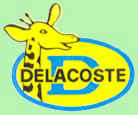
| Peter Upton's |
Subbuteo Tribute Website. |
|
Delacoste and French Production. |
|
Page 1: Introduction. |

In the golden age of Subbuteo in the 1970s and early 1980s, Subbuteo's international markets were handled by a series of exclusive distributors, unique to each individual country. These companies were often an established game producing company in that country. Italy had Edilio Parodi, Germany had Schnipp & Schuss (and later Jumbo), the USA has Jokari, and France had Delacoste. These companies would pick and choose the relevant items from the full Subbuteo range to sell in their own markets. So the French distributors sold the football and rugby games but not the cricket, and had a team range that featured mostly French league sides with a few national sides and other famous clubs also available.
Delacoste had their own numbering system but luckily they also produced their own catalogues, which can enable us to work out what items and teams they sold. The purpose of the next few pages is to illustrate and explain this range.
March 2005: As usual with Subbuteo, the more information you get, the more confusing it all gets. When I first started this article on French production, I had access to three catalogues, and it all made some kind of sense. Alas, now I have information from another three catalogues, the whole thing gets more sticky. For a start we have a whole new era to contend with....
France's Blue Period.
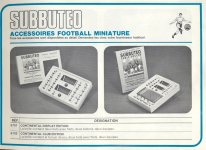
This was probably the earliest period for Subbuteo in France, given that Subbuteo exported very little before 1970. These catalogues date from the early 1970s, and as you can see from the above illustrations, they were monochrome with just a touch of a nice pastel blue. For those of you familiar with these pages, it is interesting to note that...
There isn't a mention of Delacoste on any of the pages I have scans for.
The numbering system is different than the later catalogues.
The teams were not illustrated, but did receive descriptions in the usual Subbuteo way. Like the Delacoste catalogues, the teams are listed numerically. The teams are almost in alphabetical order but there are exceptions. This suggests that there may be at least one more catalogue before this one.
The numbering system consisted of a four figure number, and the first two figures were always 57. It is worth noting that there were very few accessories advertised (just the fence, goalkeepers, footballs (x2), pitch, scoreboard, and floodlights). The numbers for the box sets were 5701-04, accessories 5720-26, and teams 5748-73. The alphabetical range of teams started at 5750, but two final French teams (Sedan, Valenciennes) had been introduced at 5748 and 5749. (In real life, both were relegated at the end of 1970-71, and both returned in 1972-73).
It is worth pointing out at this stage that the familiar heavyweight team colours produced for the French league on references 136-150 tie closely to the French top flight of 1971-72. This was the first year that Paris Saint Germain were in the top flight, and also the only year Bastia wore all-white with blue chest bars according to online sources. I assume that this is therefore the first year of the "blue" period, and this catalogue is from 1972-73 when Sedan and Valenciennes had returned. I've also heard it suggested that the original French teams had printed named boxes, as occurred in Italy and Portugal.
Interestingly, Paris SG were forcibly split in 1972-73 with Paris FC remaining in the top tier, and Paris SG relegated to the third (although they reversed league positions within a couple of years). This probably explains the confusion in the 1970s Subbuteo catalogues over the naming of these two sides.
The Delacoste Blue Catalogue.
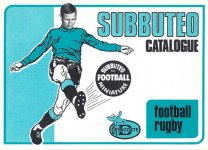
November 2023: I finally obtained a nice picture of the cover from the blue period, and the obvious thing to point out from this picture is that Delacoste are mentioned on the cover. This suggests that the blue period is simply the earlier Delacoste catalogues. It is not that straightforward though. This catalogue has the Delacoste 656.xxx numbering to teams and accessories as opposed to the 57xx numbers in the catalogue I already had scans for. Confused? Okay, so we still need a cover from the 57xx catalogue to see whether this was an early Delacoste numbering system, or something else.
The Delacoste catalogues 1975-80.
These pages are produced using four A4 Delacoste catalogues from the late 1970s, which have the advantage of being fully illustrated. Thanks to Eddie Lang and Chris Allen, who have both provided details from these catalogues.
March 2005: In this section originally, I suggested that another catalogue existed between the second and third ones illustrated. I now have details from this catalogue, so feel able to call my final catalogue "D". Obviously if some other catalogues appear, it will mess up my system yet further.
None of the French catalogues are dated, but the dates can be guessed from the contents.
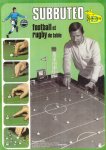 |
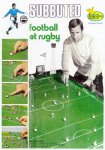 |
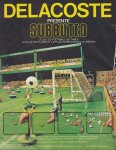 |
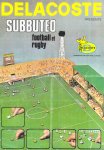 |
| Catalogue "A" | Catalogue "B" | Catalogue "C" | Catalogue "D" |
I've called these catalogues A, B, C and D so that I can indicate which catalogues each reference number set appears in. If anyone owns any different French catalogues, then please let me know.
The gentleman playing Subbuteo on the front of catalogues A and B is Raymond Kopa, "Champion International de Football". What is quite amusing is that Delacoste also placed Mr. Kopa's head on the kicking footballer logo.
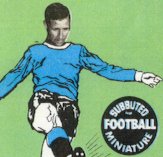
Delacoste Numbering Explained.
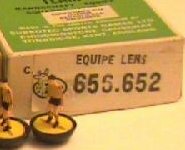
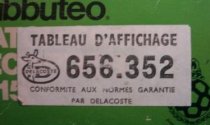
Delacoste used the English boxes for all their products, but put their own stickers on each box. The numbers used a six figure code and look complicated. In fact, only three of these numbers ever change, and one of these only changes when they started running out of numbers! The format is either 656.xx2 or 657.xx2. The xx is just a two figure number, which starts at 01, and runs into the 90s before 657.xx2 is used. The original range has box sets using 656.1x2; accessories at 656.2x2 and 656.3x2; teams at 656.4x2 to 656.7x2; and rugby in the range 656.8x2. Later catalogues filled in the gaps, sometimes working backwards towards the existing items.
1981-82.
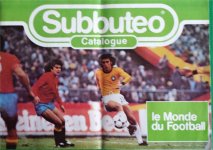
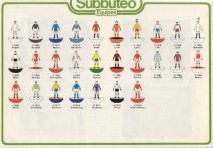
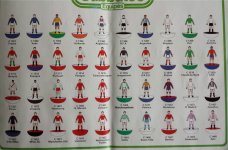
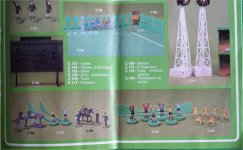
This is the Delacoste catalogue for 1981. It is similar to the British catalogue of this vintage. However, the player pictures are actually a mix of zombie and lightweight illustrations. The numbering has changed again for this one, with a "C" number for each team. On the page of French sides, the numbers start at C1005 for Angers, and finish at C1079 for Valenciennes. Obviously there are gaps, and logic would suggest that these were filled in with non-French sides in the range. Logic would be wrong though. The National sides have references in the C13xx range, whilst the international club sides are on C14xx. The national side numbers don't have gaps, but the club sides do. These sides are much reduced from previous years, which might suggest that there is a 1980 catalogue with more teams in it. However, even with that possibility, having Valenciennes on C1079 sounds like far too many French league teams, even allowing for the expanded second division coverage which was in the British catalogue of 1981, but does not seem to repeat here. More details needed.
This one is catalogue "E" in the listings.
Here the accessories have the standard British Cxxx references.
The cover is the same as the 1982-83 version shown below, but the distributor is different.
The MAKO S.A. Catalogue 1982-83.
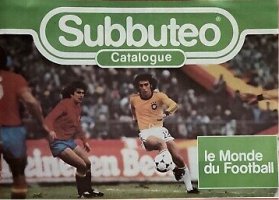
This next catalogue confuses everything even more, due to the arrival of a new distributor for France, MAKO S.A, whose address was 33 avenue Michelet, 94210 La Varenne-Saint-Hilaire. This new catalogue is not dated, but the arrival of the European Edition in the box sets (but as yet without illustration), along with the French top flight list suggests a 1982-83 date.
New distributor MAKO decided to renumber all the teams and accessories yet again, so despite the French team colours page looking superficially like the previous catalogue the numbers had again been altered. As usual, the French league teams had been laid out in alphabetical order. Here, there are 24 teams rather than the 27 shown in catalogue "E". Teams like Nice and Paris FC were been dropped, and the one new team, squeezed in out of alphabetical order at the end, was 538024 Mulhouse (who were in the top flight for a single season 1982-83). The numbers issued were all in the format 538xxx, with the xxxs being a team number starting at 538001 for Angers. The teams in the catalogue are numbered 538001-538024, which suggests that this was the first catalogue with this system. Yet oddly, the numbers are arranged in two intermixed sets of twelve. So running in alphabetical order you get 001, 013, 002, 014, 003, 015 etc until 012 and 024.
The page of international teams featured 33 teams; 17 national sides, and 15 big European club sides. These are not alphabetical but follow the strange doubling up of numbers described earlier. Here, the International teams are 538030-46 and the club sides 53850-65.
The accessories have a 53xxxx format that seems to make little sense. The Accessory pictures are taken from the UK catalogue dated 1980, but enlarged. This means some of the accessories (goalkeepers with caps, small balls, the police set etc) are illustrated with a star (*) instead of a reference number, which the catalogue informs are "non disponible en France". How annoying must that have been?
The catalogue also had a full page advert to join the Subbuteo Association Francaise (President Jean-Michel Larque). (25 francs if you were under 16 years old, otherwise 60 francs)
If all this explanation page has not put you off, you can now have a look at the French box sets and accessories, or the French league sides, or other teams sold in France.